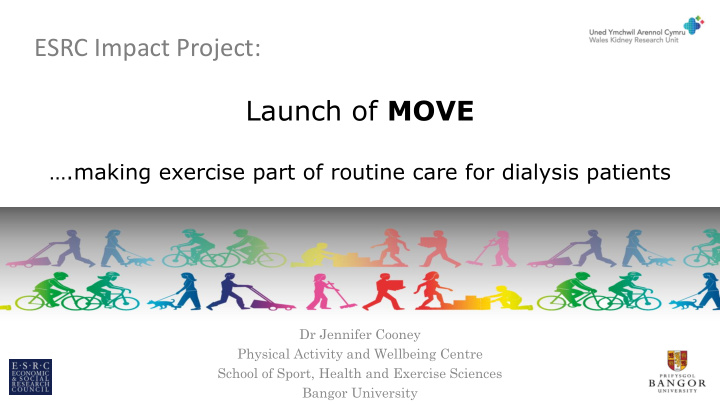



ESRC Impact Project: Launch of MOVE ….making exercise part of routine care for dialysis patients Dr Jennifer Cooney Physical Activity and Wellbeing Centre School of Sport, Health and Exercise Sciences Bangor University
12 months Submission of application to Bangor University ESRC Impact Acceleration Account Proposal of impact project Application successful WKRU meeting, Cardiff – funding awarded Project start
Since then ……….. What have we done? Focus group discussions with Health Professionals and Dialysis Patients Benefits of exercise, impact of physical inactivity Facilitators and barriers to intra-dialytic exercise Exercise as part of routine care – thoughts and actions
What Dialysis Patients said …… Barriers to intra-dialytic exercise Benefits of exercise Staff don’t have time Being able to do daily activities I need to stay still Makes me feel better Staff don’t know how to use the equipment Better mental health and physical health Independence and getting out and about Facilitators to intra-dialytic exercise The staff are great! Impact of physical inactivity Poor physical and mental health You do even less What would make it easier for you to exercise? Exercise during dialysis Family support Being assessed to show progress Staff to support and motivate us
What Heath Professionals said …… How can health professionals help patients to be more active? Provide better education/instruction Benefits of exercise Prescribe exercise Feel better/better wellbeing Assess patient ability Improved QoL Encourage and re-enforce physical activity Better mental health Better physical health, health outcomes Barriers to intra-dialytic exercise Able to do more Staff don’t have knowledge or resources Less frailty Staff time/shortages Staff may not be willing to implement Impact of physical inactivity Able to do even less Poor mental health Facilitators to intra-dialytic exercise Muscle wastage Good team – staff are excellent Poor fitness Exercise as part of routine care Staff are willing to support/implement exercise Essential and important There is down time when exercise could be implemented Much needed Needs promoting Requires resources Well overdue
MOVE Resources MOVE website: move.bangor.ac.uk Information for Health Professionals Information for Dialysis Patients
Information for Dialysis Patients Patient Booklet: Importance of physical activity Recognise current physical activity habits Current physical activity guidelines How to increase physical activity Goal setting Exercising safely Aerobic, muscle strength, flexibility exercises – intensity, progression Muscle strengthening exercises – at home and during dialysis Keep track of progress – diaries to log activity
Information for Dialysis Patients Exercise at Home Videos Muscle Strengthening Exercises Upper body exercises Lower body exercises Seated options Flexibility Exercises Upper body exercises Lower body exercises Seated options
Information for Dialysis Patients Exercise during Dialysis Videos Muscle Strengthening Exercises Upper body exercises Lower body exercises
Information for Health Professionals Health Professional Guide: Importance of physical activity Exercise as part of routine care Is my patient active enough? Screening patients Assessment of patients How to prescribe exercise – during dialysis/outside of renal unit Aerobic, strength, flexibility exercises Intradialytic exercise – safety, monitoring and how to implement All forms required provided
Information for Health Professionals Intradialytic Cycling Equipment I ona’s Training Experience
Implementation – how can you help? Help make exercise part of routine care………. Familiarise yourself with MOVE resources Incorporate physical activity into discussions with patients and family dialysis unit, ward rounds, routine appointments MDT approach required for success Identify exercise champion/s to drive new initiative identification, screening, assessment, exercise prescription PRESCRIBE exercise – during dialysis and/outside of renal unit Signpost patients to MOVE website and My Get Active Guide Encourage, follow up and re-enforce You can make exercise the “norm” for dialysis patients!
What next? We need your feedback…… Health Professionals and Dialysis patients to complete Feedback Questionnaire Where can I find the feedback questionnaire? Complete online (MOVE Website): move.bangor.ac.uk OR Paper copy available and FREEPOST envelope Contact Information: Dr Jennifer Cooney Physical Activity and Wellbeing Centre School of Sport, Health and Exercise Sciences Bangor University LL57 2PZ Email: j.cooney@bangor.ac.uk
Recommend
More recommend